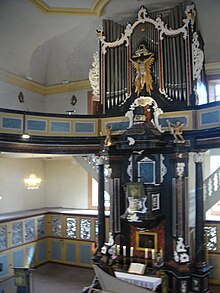Christophorus Church (Wiesbaden)
The Christophoruskirche in the Schierstein district of the Hessian state capital Wiesbaden is a Protestant church, which was built from 1752 to 1754 in the style of the expiring Baroque and Rococo .
history
After part of the tower of the old Schierstein church collapsed in 1752, the new building plans by the architect Johann Wilhelm Faber , which had been discussed in previous years, suddenly became urgent. The Kurmainzische Oberbaudirektor Anselm Franz Freiherr von Ritter zu Groenesteyn made the vegetable garden of his country estate available as a building plot. The foundation stone was laid on May 3, 1752, and the new church was consecrated on September 15, 1754. In 1962 the Schiersteiner Kantorei was founded in the municipality.
architecture
Exterior
As usual, the church was built in an east-west direction with the choir in the east. It is a hall church . The external floor plan (length 24 m, width 15 m) corresponds to the golden ratio . The good acoustics of the interior may be due to this.
The tower, which is now slightly inclined to the west, a Welsche Haube , does not rest on its own foundation, but is attached to the roof structure as a ridge turret . Contrary to common practice, he is in the east. The tower pole carries the globe, the cross and the weathercock . The beams and the roof structure are made of fir wood from the Fichtel Mountains . The thin ceiling of stuccoed canvas hangs from a beam that runs from east to west.
Interior
While the exterior is kept rather simple, the interior is rococo in color, liveliness and attention to detail. The structure of the chancel, on the other hand, is typical of the Protestant conception of the trinity and equality of the altar (sacrament), pulpit (preaching and interpretation of the word) and organ (praise / participation of the community). Together with the organ galleries, a cross was created optically. The four Corinthian columns in the chancel symbolize the four Gospels as God's message to the world through Jesus Christ. And according to 1 Cor. 13, 13 the putti mean faith (with the chalice), hope (with the anchor) and - in the middle - love. She keeps the law: the Ten Commandments. The realistic depiction of the crucified is surrounded by a golden halo. Twelve Doric columns as symbols of the twelve apostles, the twelve tribes of Israel and the community carry the galleries in the ship. All of the carvings were made by the Frankfurt wood sculptor Johann Daniel Schnorr. The Nassau coat of arms is an interesting symbol of absolutism on the pulpit: the subject who looks up to the preacher of the gospel should never forget that he also has a secular master and that the sermon also expresses the princely will. It is the coat of arms of the sovereign Karl von Nassau-Usingen . The Schierstein coat of arms can be found on the right side of the pulpit. In the chancel are the twelve graves of the Reichsfreiherr Langwerth von Simmern family , who held the church patronage. The family coat of arms can be seen on the left on the choir stalls. The right is that of the Frankfurt mayor Johann Georg von Schweitzer. Furthermore, the wife and son of Pastor Philipp Bernhard Schwarz - the initiator of the church building - are buried in the chancel.
The altar cross comes from the contemporary metal sculptor Prof. Klump (Wiesbaden). You can see gold with rock crystal as a symbol of Christ, 12 rubies for the apostles and the symbols for the feeding of the five thousand. Behind it Ecce Homo (Christ before Pilatus; the scene has been moved to Darmstadt's market square) by Johann Conrad Seekatz . In the interior there is also the wedding at Cana by Paolo Veronese (original in the Louvre ), in an old copy around 1600, Abraham's sacrifice by Cornelis de Vos , painted for the cathedral of Pisa, where the painting hung for 300 years and the mercy seat (God the Father with Son and Holy Spirit), Middle Rhine, probably 17th century, as well as an Easter candlestick, Northern Italy, around 1780. The lecture cross bears the inscription: "Maria Magdalena Heymann". The nativity scene in the Neapolitan style (carved and clothed figures) is shown from Christmas Eve to Candlemas . The paternoster bell made of bronze was cast in Mainz around 1430 (inscription "Meyster Johann von Mence der gos mec"). The offering box and veil boards on the organ front come from the old church that stood in the old cemetery (today's Söhnlein complex).
organ
The organ was built in 1963 by the organ building company Förster and Nicolaus (Lich) . The instrument has 21 stops on two manuals and a pedal . The playing and stop actions are mechanical.
|
|
|
||||||||||||||||||||||||||||||||||||||||||||||||||||||||||||||||||||||||||||||
- Coupling : II / I, I / P, II / P
literature
- Baedeker Wiesbaden Rheingau . Baedeker, Ostfildern-Kemnat 2001, ISBN 3-87954-076-4 .
Individual evidence
Web links
Coordinates: 50 ° 2 ′ 37.1 ″ N , 8 ° 11 ′ 43.9 ″ E

